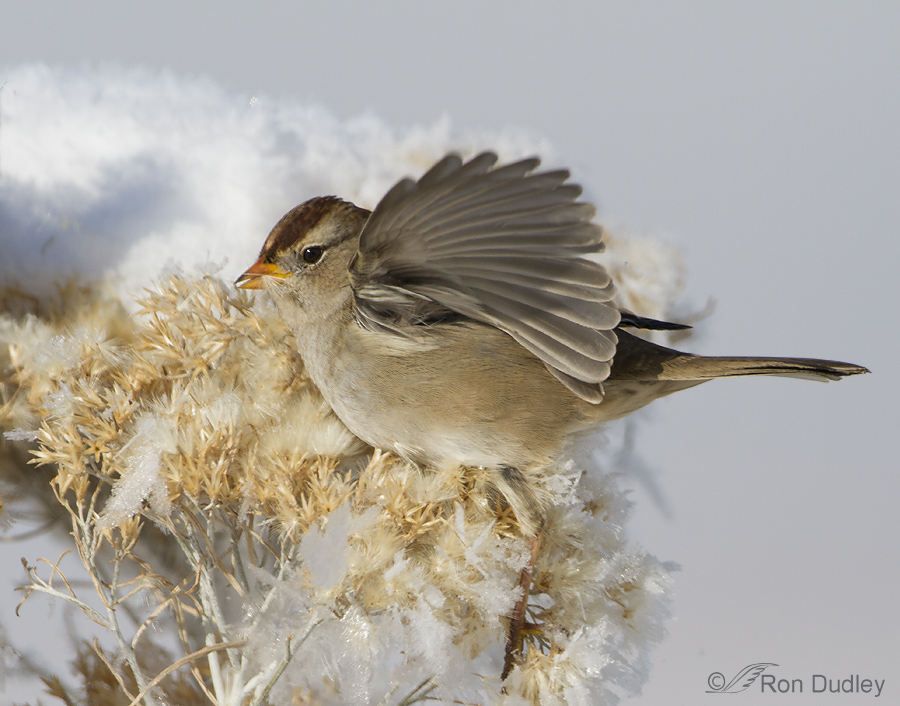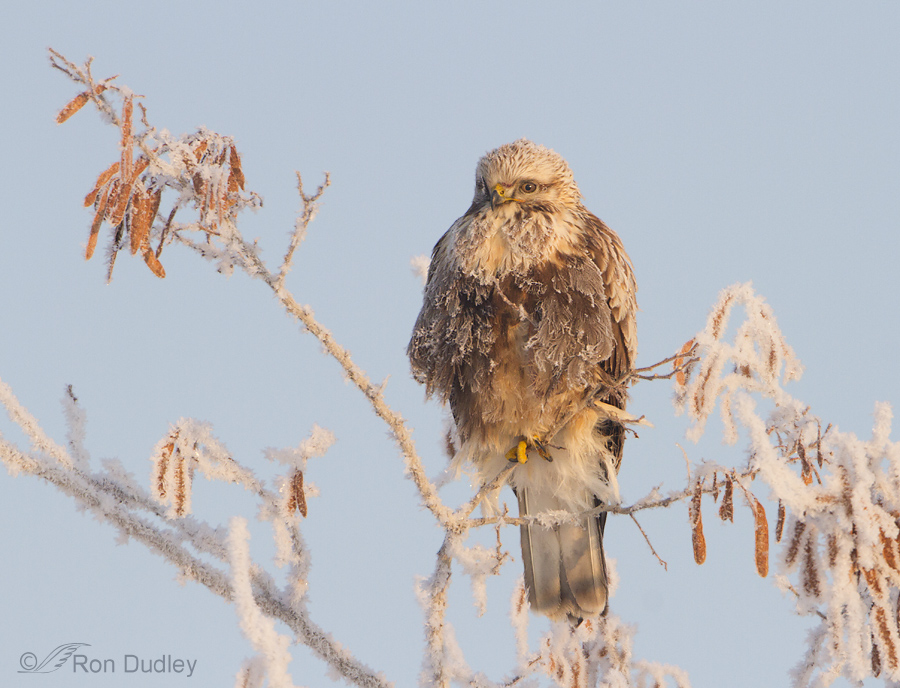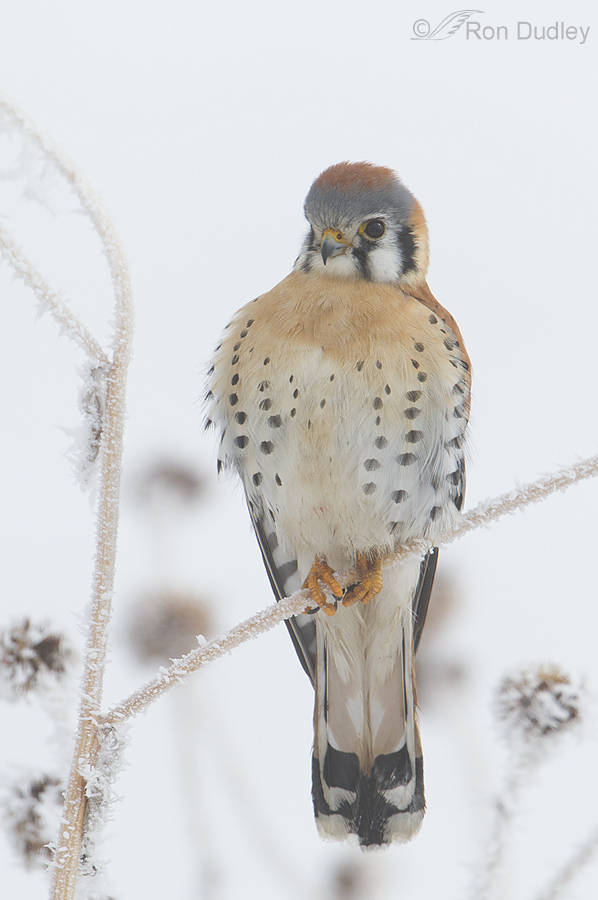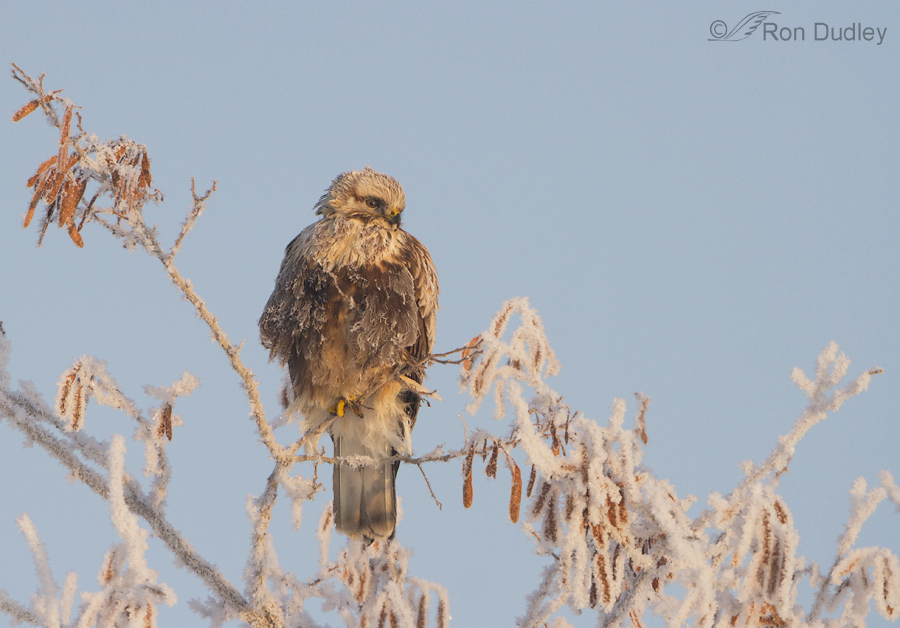Tag: frost
Several Sparrow Species In Frost And Snow

In my area most sparrow species aren’t easy to approach or catch out in the open for most of the year but when it’s very cold and they decide it’s time to begin their communal morning feeding routine they become much braver souls. Earlier this week I photographed three species of sparrows as they harvested seeds from their frost-covered parent plants.
Rough-legged Hawk In A Frosty Wonderland

During winter, photography in the valley of the Great Salt Lake can be difficult at best due to frequent inversions that trap fog and smog in the low-lying areas and that especially includes the marshes near the lake. These inversions often last for days or even weeks and the fog and smog get progressively worse each day. But the fortunate result for photographers is the thick hoarfrost that blankets everything in the vicinity of the lake if and when the fog burns off during the day.
American Kestrel In Fog

Images of birds in fog often have a unique mood and “feel”. The tendency of many photographers is to attempt to minimize the effects of the fog during processing but I try to resist that temptation and let the image sink or swim on its true merits.
Fog tends to reduce detail and color saturation and causes the subject to appear slightly overexposed. It also often results in high key backgrounds. Some of those effects can be reduced by increasing contrast/saturation during processing but then you are losing the mood provided by the fog in the first place. All I’ve done with this image is crop and sharpen.
Barn Owl Hunting Over A Hoarfrosted Hill
The Barn Owls are still hunting sporadically during daylight in northern Utah. I’ve seen them doing so in a variety of areas and heard reports of it happening elsewhere. Some areas near the Great Salt Lake are literally “magical wonderlands” in the early mornings due to the thick layer of hoarfrost that covers nearly everything. The frost falls off the vegetation during the day, then reforms during the night. The hoarfrost produces a setting for my images that appeals to me. The camera settings for the images in this post were: 1/3200, f/7.1, ISO 500, 500 f/4. The owl was not baited, set up or called in. Yesterday morning this owl was hunting along the upper edge of a steep-sided hill as it came in my general direction and then rounded the hill to my right. In the first four shots you can see that its attention is riveted to the side of the hill where the snow cover is much less deep than it is everywhere else, which would increase the chances of spotting a vole. I chose to compose these images a little differently so that the frost-covered hunting ground becomes almost as important to the image as the bird. If you have any thoughts on this composition I’d be interested in hearing them. As the bird rounded the hilltop and got closer to me the frosted vegetation became more dominant in the images. You can see that the snow on the hillside is patchy (most of the white is frost) so I believe that…
Does Anyone Know What’s Wrong With The Eye Of This Northern Harrier?
It’s very cold here in northern Utah (8 degrees F. as I type) and there’s lots of snow on the ground – ideal conditions for photographing hunting Northern Harriers. And yesterday morning everything was covered with a thick layer of hoar-frost which turned the marshes into a frosty fairyland. I was able to get lots of shots of this particular bird and in the field I didn’t even notice that there was anything unusual about it. Most of the images were flight shots and there just isn’t time pay attention to detail when you’re concentrating so hard on keeping the bird in the frame and in focus. But when I got home and started reviewing my images I was taken aback. Something’s definitely going on with the right eye of this bird. At first I thought it might be just the closed nictitating membrane but I have dozens of shots of this bird and the eye is the same in all of them. It’s definitely not a normal membrane, if it’s the membrane at all. A better look at the right eye. This is probably the sharpest, most detailed image I was able to get of the bird. An extreme crop of the previous image to show the best detail I could manage. To my untrained eye it looks like there may be some kind of fungal growth in and around the eye that may have discolored the eye ring and nictitating membrane and closed the membrane permanently, but that’s only a guess….
Song Sparrow In A Frosty Wonderland
It’s my natural tendency to avoid public displays of sentiment (another character flaw…) but recently I’ve been reflecting on just how much I enjoy blogging and interacting with my readers. Even though I’ve never actually met most of you, I can’t help but feel that we have become “friends” on some level. And this time of year especially, I think of my friends. Friends usually share at least some common interests and for us it seems to be a mix of birds, nature and/or photography. Many of you are more knowledgeable in those areas than I am and have graciously shared your expertise and experiences with me and others. For that I am grateful. So I wanted to wish each of you the very best this holiday season. I hope you’re with family and loved ones and that your experiences over the next few days will add to your cherished memories down the road. I wish you a safe and joyous holiday season! Ron About the image: The bird is a Song Sparrow, plucking seeds from a hoar frost covered stem on a very cold and magical early morning on the refuge wetlands. You can see frost falling near the tail from the feeding activity.
Barn Owl Hunting Low In The Phrags
Usually when I’m photographing hunting Barn Owls they’re flying above the stands of Phragmites so I typically get a sky background. If I’m lucky they’ll be low enough so that I include some of the phrags at the bottom of the frame to include habitat in the image. 1/1600, f/8, ISO 400, 500 f/4, 1.4 tc, natural light, not baited, set up or called in But occasionally the bird will drop down low enough so that I get only phrags in the background and no sky. For the sake of variety I like the effect, though it sure makes it difficult to keep focus locked on the bird with the vegetation in the background so close to the owl. 1/2000, f/8, ISO 400, 500 f/4, 1.4 tc, natural light, not baited, set up or called in On the very next pass the owl was high enough that I got some sky in the background, along with the frosty Phragmites plumes. 1/2000, f/8, ISO 400, 500 f/4, 1.4 tc, natural light, not baited, set up or called in Two shots in the burst later the owl was slightly past me and beginning to turn away but this angle gave me a strong catch light in the eye and a somewhat dramatic look at the fully extended left wing. It’s fascinating to watch these birds in the air. Their buoyant flight with deep, slow wingbeats as they cruise rather slowly will change dramatically when they twist and turn at the beginning of a dive for prey. These owls…
Frosty Northern Harrier
This is a shot that I like, partly due to the somewhat unusual effects of the light and the resulting colors. 1/1250, f/8, ISO 500, 500 f/4, 1.4 tc, shot from pickup window, not baited, set up or called in It was taken on a very cold January morning (notice the frosty perch) just as the sun was coming up over the Wasatch mountains and the warm colors from the very low sun, combined with the light bouncing off all of the Phragmites in the area, gave the overall image a bit of a slightly unusual color that appeals to me (as usual, I made no color adjustments during processing). After my last post on composition it seems that I’m fretting about cropping options even more than I usually do. I often try several versions, make a decision, then use (or post) just the one I think I like best. But in this instance I just wasn’t sure, so I decided to post two versions. Typically, my gut instinct is to go for the tighter crop (the vertical in this case) because of the better detail on the bird, but I’m trying to expand my horizons a little and become more flexible with the options I consider. If you have a preference between these two images I’d love to hear about it, but please don’t think you need to choose one over the other if you decide to comment on the image. And this will be the last time (at least for a good long…
American Kestrels In Snow, Frost And Fog
Photographing American Kestrels near the Great Salt Lake during the coldest parts of winter is a two-edged sword. On the one hand the frigid temperatures in December and January make the kestrels “stickier” – much less likely to fly off before you can get close enough for quality photos. But there’s a down side too. Moisture from the lake often forms fog or at least makes the air so incredibly laden with moisture that good lighting often becomes an issue. I’ll still take the shot under some of those conditions though – a close-up with the bird large enough to very nearly fill the frame is still usually much more desirable than a well-lit bird so small in the frame that little detail can be seen. 2000, f/7.1, ISO 400, 500 f/4, 1.4 tc In this image the background is snow and there had been a blizzard the day before which had stacked snow up on one side of the perch. This was one of the first times I’d ever been close enough to a kestrel to get a frame-filling image and I well remember having a case of “buck fever” while photographing him at such close range. Also a bit unusual was the fact that I was actually looking slightly down at him – something that doesn’t happen often with kestrels. 1600, f/7.1, ISO 500, 500 f/4, 1.4 tc This shot illustrates well what you get when the atmosphere is so laden with moisture when it’s very cold – fog, low but even light, some reduction in detail and sometimes…
Barn Owls and Phragmites
Barn Owls are among my favorite avian subjects. They’re uncommon, elusive and rarely active in daytime so they’re devilishly difficult to photograph in good light – especially in flight. And they’re unique – so different from other owl species (heart-shaped facial disc, smaller eyes, a short squared tail and serrated central claws) that they’re given their own family classification – Tytonidae. They’re the most wide-spread species of owl on earth, though their numbers are declining. Occasionally, very occasionally, I’ve had the opportunity to photograph them in daylight. Around here they can sometimes be found hunting for voles at the edge of Phragmites stands at the local marshes during the early mornings of the coldest days of winter. Phragmites is a very large perennial grass found in our wetlands that causes many problems for wetlands managers because it produces substances that are toxic to more beneficial species of marsh plants. 1/2000, f/8, ISO 400 1.4 tc As problematic as Phragmites can be I’ve found it to be a wonderful background for photographs of birds in flight. And since these owls fly during daytime only when it’s very cold the Phragmites is often covered with heavy frost in the mornings which can soften the background and make it very pleasing to the eye. If the grasses are close to the bird they appear fairly well-defined. 1/2000, f/8, ISO 400 1.4 tc But if they’re far away the bokeh of the background is softened even more, giving relatively subtle hints of texture and form. I think the sharper foreground phrags in this photo…
Just A Shot That I Like… #1
Today I’m starting a new feature on FeatheredPhotography. Typically my posts include multiple images showing a sequence of photos that illustrate bird behaviors, photo techniques, favorite shooting locations and the like. That will not change. But now, in addition I will post a single shot that appeals to me for whatever reason and title the post “Just A Shot That I Like…” and these image posts will be numbered. This is post #1. The photos I choose may be new or from my archives. I’ll mention what I like about the photograph and any significant flaws I think it has. I’ll also include my image techs. My plan is to make one of these posts at least once per week, in addition to my regular posts. 1/2500, f/7.1, ISO 500, 500 f/4, 1.4 tc I found this Song Sparrow early in January 2010 on the coldest day so far that winter. The entire refuge was covered in thick frost – it looked like a magical frosty fairyland all the way to the horizon. The sparrow was puffed up to keep warm and eating ice encased seeds it grabbed from its twiggy perch. I like the frost, the vertical position of the tail, the puffed up squatting pose, the ice crystals falling next to the tail and the whimsical mood of the image. Ron


